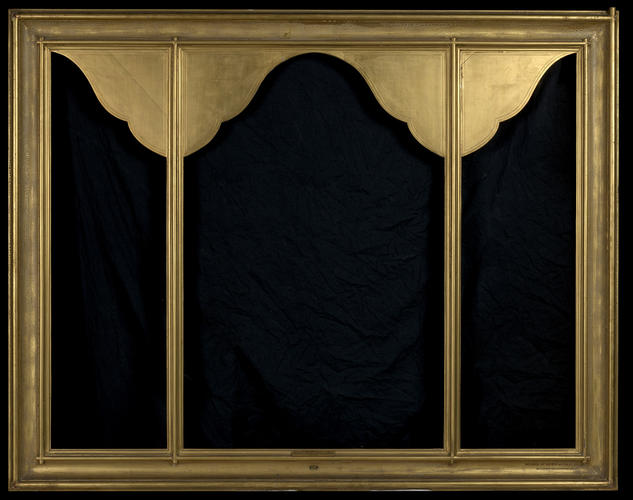Frame for RCIN 404759, Flemish School, Triptych: Adoration of The Kings, with Saints and Donors mid-19th-century
159.5 x 126.4 x 5.3 cm (frame, external) | RCIN 7404759
-
This frame, with its distinctive crossed rails, surrounds the majority of paintings that formed part of the art collection of Prince Ludwig von Oettingen-Wallerstein (1791-1870), a distant relative of Prince Albert’s stepmother, Marie of Württemberg. His collection would have been displayed at Wallerstein Castle, situated north-west of Munich. The group of 100 works, consisting of German, Netherlandish, and early Italian paintings along with a few Byzantine and Russian works, was surety for a private loan between the German collector and Prince Albert in 1847. Prince Ludwig, a Bavarian politician, was a passionate art collector, and it was his love of art that presumably saw him in debt and requiring a loan. The group of paintings was first shown at Kensington Palace in 1848 however, when no buyer for the collection was found, it was ceded to Prince Albert; 25 paintings were accepted by the National Gallery in 1863.
A handful of the pictures retained their earlier frames – these appear to be nineteenth century painted and gilded German frames (see RCINs 7403387, 7403493) - whilst the majority probably were reframed c. 1851-56 in these unusually plain frames. Some paintings were included in the landmark Art Treasures exhibition in Manchester in 1857 and still retain exhibition labels on their frame backs confirming that reframing took place prior to 1857. Many also bear a brand, on the reverse, with the year 1866 and a room location indicating they were displayed in the Chapel created in 1843 for Queen Victoria and Prince Albert on the south-west corner of Buckingham Palace (now The Queen’s Gallery). In the Victorian inventory drawn up by Richard Redgrave the majority are recorded in the nearby Chapel Gallery; some of the frames are visible in Laurits Tuxen’s painting of the Marriage of Princess Maud of Wales in 1896 (RCIN 404464).
The simple crossed rail design may have been thought to complement the religious subjects of the majority of the paintings, whilst also satisfying Prince Albert’s love of uniformity. The design is in contrast to the delicate frames of scrolling gilt foliage against a bright blue ground selected by Albert and his art advisor Ludwig Grüner for his collection of early Italian masters that adorned the walls in his Writing Room at Osborne House (see 926224 and 7400039, 7403954) and to the more conventional frames commissioned by the Prince for the Picture Gallery at Buckingham Palace at around the same time. Some of the frames retain a shield bearing the coat of arms of the Prince of Oettingen-Wallerstein (presumably removed from the original frames and re-applied), while curiously Prince Albert’s coat of arms and motto was added to the base of some of the frames in 1864 ; both appear rather incongruous to the modest frame.
The frames are made of pine and keyed (have a shaped piece of timber used on the rear side to secure each mitre joint) indicating that they are British, but Grüner may again have been involved in their design; the closest comparison is with a German frame (with gilded rails on a blue ground) produced in the region of Schwangau, southern Germany in about 1849. The closest connection in Britain is with the ‘Oxford frame’, named after the Oxford Movement, a religious movement originating at the University of Oxford; these frames, with their corners crossed in a manner similar to the ‘Oxford’ corners used by printers, took their name from their association with publications of the Movement. However, the earliest reference to these frames is in the mid-1860s, a number of years after Albert’s death in 1861, suggesting the German connection is more likely.
None of the paintings selected by the National Gallery in 1863 have retained these frames. According to their records the paintings were restored, and the frames were ‘received, regilt & altered’, probably by Henry Critchfield, who worked for the Gallery from 1854-1880.
-
Creator(s)
-
Medium and techniques
Measurements
159.5 x 126.4 x 5.3 cm (frame, external)
159.5 x 126.4 x 7.7 cm (frame, external, + buildup)
Category
Object type(s)








